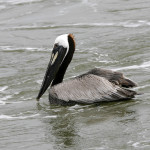• • •
Brown Pelicans are large and ungainly birds with a distinctive bill pouch. Look for them gliding in packs along the shore or floating on the water just beyond the breaking waves. Along the bay, they roost on pilings, line up on the docks or follow behind ships that stir up fish in their wake.
• Length: 48 inches
• Wingspan: 84 inches
• Season: Year-round
More about Brown Pelicans.
Where they are, and when.
With their enormous wingspan, Pelicans soar inches above the water with little effort. When feeding, they make abrupt, twisting dives, pulling their wings in and plunging headlong into the water to capture fish. When they surface, they drain the water from their pouch before tossing the fish down their throat.
During breeding season, the back of their necks transition from white to a dark chestnut, and the yellow on their crown deepens and grows. (Juveniles are more uniformly brown.) When courting, they display and inflate their pouches.
Brown Pelicans nest in large colonies on coastal islands, where they are protected from predators. They typically produce two to four white eggs, but not all of the chicks survive to leave the nest. The nests are simple structures on a scrape of ground or more elaborate stick platforms when built in the trees.
May 15, 2012
At either side of the Bolivar Ferry, Brown Pelicans queue up on the dock and perch placidly on the pilings. They’re fully integrated, with American White Pelicans scattered among the group about every sixth or seventh bird. As the ferry pulls out, they launch en masse behind it, trolling for fish turned up in the ship’s wake. Because they’re soaring at the ferry’s pace, they stand still in the air around the stern, occasionally diving into the water and throwing down a fish. Often, they’re joined by a flock of laughing gulls, who are looking more for handouts from the boat’s rail. Once capturing a fish, the pelicans sit quietly on the foamy water finishing their meal and floating into the distance as the boat pulls away.








